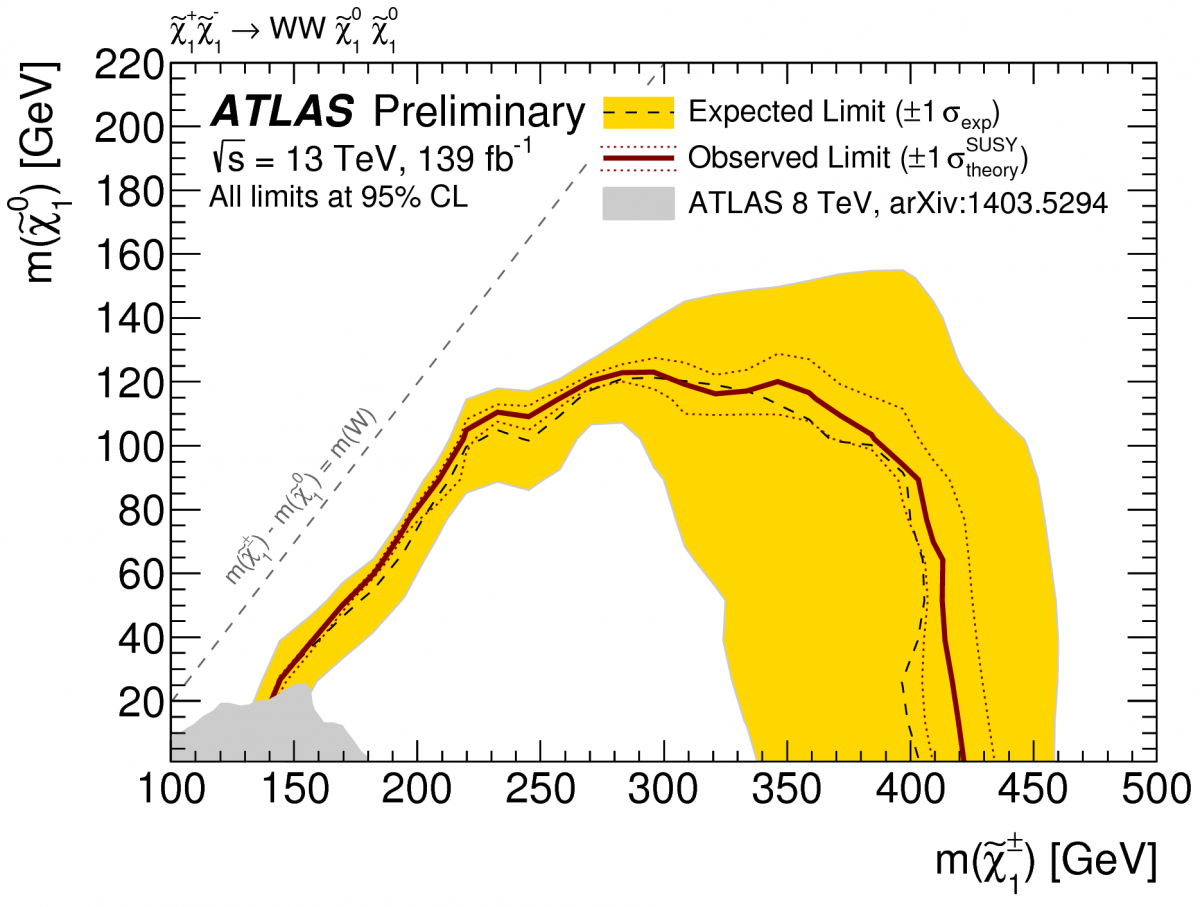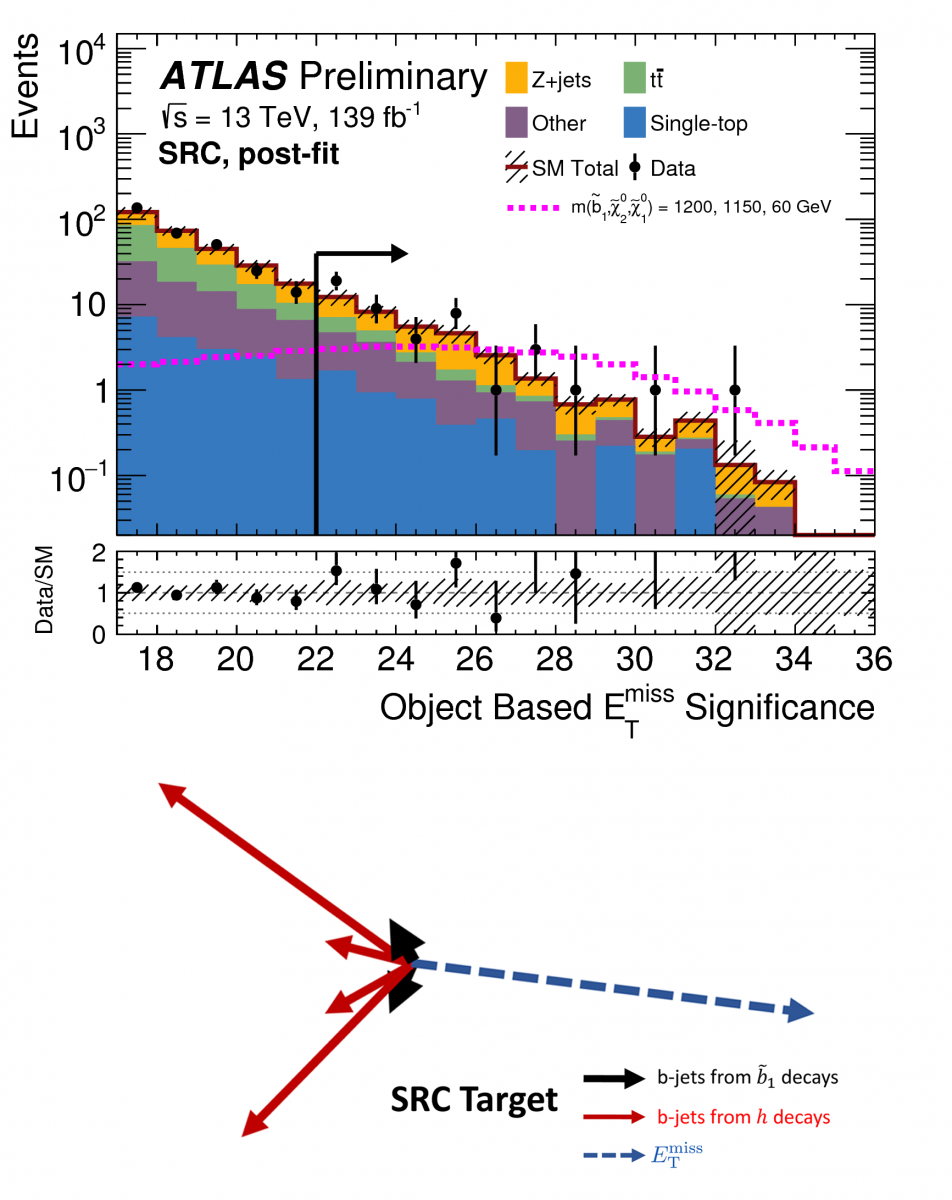ATLAS sets strong constraints on supersymmetric dark matter
8 April 2019 | By

One of the most complete theoretical frameworks that includes a dark matter candidate is supersymmetry. Dark matter is an unknown type of matter present in the universe, which could be of particle origin. Many supersymmetric models predict the existence of a new stable, invisible particle – the lightest supersymmetric particle (LSP) – which has the right properties to be a dark matter particle. The ATLAS Collaboration has recently reported two new results on searches for an LSP where it exploited the experiment’s full “Run 2” data sample taken at 13 TeV proton-proton collision energy. The analyses looked for the pair production of two heavy supersymmetric particles, each of which decays to observable Standard Model particles and an LSP in the detector.
Identifying missing energy

A central challenge of these searches is that dark matter candidate particles would escape the ATLAS detector without leaving a visible signal. Their presence can only be inferred through the magnitude of the collision’s missing transverse momentum (ETmiss) – an imbalance in the momenta of detected particles in the plane perpendicular to the colliding protons. In the dense environment of numerous overlapping LHC collisions it can be difficult to separate genuine ETmiss from fake ETmiss originating from mismeasurement of the visible collision debris in the detector.
To resolve this difficulty, ATLAS developed a new ETmiss significance variable, which quantifies the likelihood that the observed ETmiss originates from undetectable particles rather than from mismeasured objects. Unlike previous calculations based entirely on the reconstructed event kinematics, the new variable also considers the resolution and misidentification probability of each of the reconstructed particles used in the calculation. This helps discriminate more effectively between events with genuine and fake ETmiss, respectively, as shown in Figure 1, thus improving ATLAS’ ability to identify and partially reconstruct dark matter particles.
A central challenge of these searches is that dark matter candidate particles would escape the ATLAS detector without leaving a visible signal.
Applying new reconstruction techniques

Both of the new ATLAS searches implement this new reconstruction technique to the full Run 2 dataset. One search looks for the pair production of charginos (the charged superpartners of bosons) and sleptons (superpartners of leptons), respectively, which decay to either two electrons or muons and give rise to large ETmiss due to the escaping LSPs. These signals are very challenging to extract as they look similar to Standard Model diboson processes, where some (although less) ETmiss is produced from invisible neutrinos. Events were selected at high ETmiss significance together with several other variables that help discriminate signal from background. In absence of a significant excess in the data over the background expectation, strong limits were placed on the considered supersymmetric scenarios, as shown in Figure 2.
The second new search targets the pair production of supersymmetric bottom squarks (superpartners of bottom quarks), which both decay to a final state involving a Higgs boson and an LSP (plus an additional b-quark). Then – targeting Higgs boson decays to two b-quarks, as it is predicted to occur 58% of the time – the final state measured in the ATLAS detector would have a unique signature: large ETmiss associated with up to six “jets” of hadronic particles, originating from b-quarks. The measured and expected ETmiss significance distribution and expected event topology are shown in Figure 3. Again, no significant excess in data was found in this search.
Both results place strong constraints on important supersymmetric scenarios, which will guide future ATLAS searches. Further, they provide an example how novel reconstruction techniques can help improve the sensitivity of new physics searches at the LHC.
Links
- Search for bottom-squark pair production with the ATLAS detector in final states containing Higgs bosons, b-jets and missing transverse momentum (ATLAS-CONF-2019-011).
- Search for electroweak production of charginos and sleptons decaying in final states with two leptons and missing transverse momentum in 13 TeV proton-proton collisions using the ATLAS detector (ATLAS-CONF-2019-008).
- See also the full lists of ATLAS Conference Notes and ATLAS Physics Papers.



